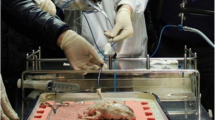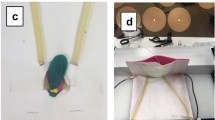Abstract
Percutaneous endourological procedures require an advanced level of skills. To facilitate training in the proper technique, simulators are helpful. Non-biological models, useful for learning the basic steps, do not represent the clinical situation in an ideal way. Recently, we developed a porcine urinary tract model for ureteroscopy. Proceeding from this experience, we developed a further ex vivo model for training percutaneous endourological procedures. The kidney with the ureter is dissected off of the retroperitoneal organ package of freshly slaughtered pigs. It is embedded in silicon. The renal pelvis can be filled with saline to simulate hydronephrosis, stones can be implanted for percutaneous nephrolithotomy. This ex vivo model allows training of all percutaneous endourological procedures (e.g. percutaneous nephrostomy, percutaneous lithotomy, endopyelotomy). It is an ideal way to train these techniques, being superior to non-biological models in terms of “tissue feeling” for anatomic relations, and the great variety of procedures that can be trained. Nevertheless, it is readily available and inexpensive.






Similar content being viewed by others
References
Puppo P (1999) Percutaneous nephrolithotripsy. Curr Opinion Urol 9: 325
Wong MYC (2001) An update on percutaneous nephrolithotomy in the management of urinary calculi. Curr Opinion Urol 11: 367
Sampaio FJB, D’Anunciacao AL, Silva ECG (1997) Comparative follow-up of patients with acute and obtuse infundibulum-pelvic angle submitted to extracorporeal shock wave lithotripsy for lower caliceal stones: preliminary report proposed study design. J Endourol 11: 157
Chow GK, Streem SB (1998) Contemporary urological intervention for cystinuric patients: immediate and long-term impact and implications. J Urol 160: 341
Strohmaier WL, Schubert G, Rosenkranz T, Weigl A (1999) Comparison of extracorporeal shock wave lithotripsy and ureteroscopy in the treatment of ureteral stones: a prospective study. Eur Urol 36: 376
Hammond L, Ketchum J, Schwartz BF(2004) A new approach to urology training: a laboratory model for percutaneous nephrolithotomy. J Urol 172: 1950
Strohmaier WL, Giese A (2001) Porcine urinary tract as a training model for ureteroscopy. Urol Int 66: 30
Acknowledgements
Presented in parts at the 10th European Symposium on Urolithiasis, Istanbul, 2003. German Patent and European patents pending.
Author information
Authors and Affiliations
Corresponding author
Rights and permissions
About this article
Cite this article
Strohmaier, W.L., Giese, A. Ex vivo training model for percutaneous renal surgery. Urol Res 33, 191–193 (2005). https://doi.org/10.1007/s00240-005-0478-2
Received:
Accepted:
Published:
Issue Date:
DOI: https://doi.org/10.1007/s00240-005-0478-2




